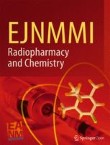Topical Collections about latest and interesting topics in EJNMMI Radiopharmacy and Chemistry are available at: https://link.springer.com/journal/41824/collections
Correction to: Advances in the automated synthesis of 6-[18F]Fluoro-L-DOPA
An amendment to this paper has been published and can be accessed via the original article.

